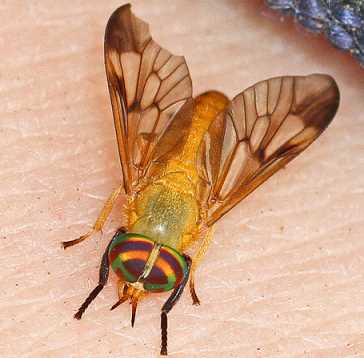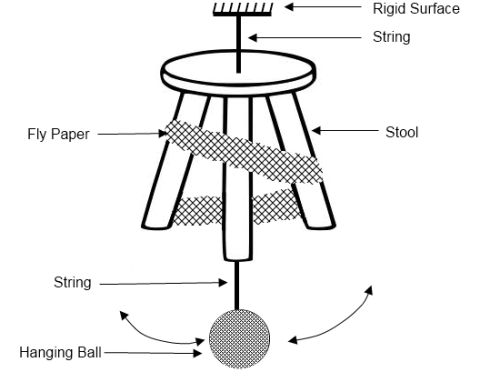Yellow biting flies are one of the fiercest types of flies present in the world. These flies are mostly found in the south-eastern parts of U.S. from New Jersey to Texas; Bahamas; Mexico to Costa Rica. The physical appearance of these flies is very much similar to deer flies and hence any one can easily get confused while identifying them.
As the name suggests, these are yellow bodied flies and the most important thing about them is, their ability to bite (however male species do not bite). Their bites are painful, itchy and may also cause swelling in some cases.
Yellow flies prefer warm and humid weather conditions and are most active during the day time just before the twilight. They mostly stay near large water bodies where they can lay eggs and hence are mostly found in forests near streams or lakes.
In this article, we are going to see how to get rid of yellow biting flies, but before that let’s have a look at their physical attributes so that we can identify them easily.
Identifying Yellow Biting Flies:
Physical Appearance:
Adult yellow flies are predominantly yellowish in color and about 1 – 1.2 cm long. The font pair of legs are black in color while the other pairs are yellowish–gray. The wings are clear with black stigma and brown or tan patches near the apex of wing, and this is the thing that helps them to distinguish from deer flies, which have these brown or tan patches across the middle of wings.

Yellow flies have a black stripped, yellow furry abdomen, with brilliant blue-green eyes. In some species, the yellow abdomen is covered with a black haired lining along the sides with a broad yellow stripe along the middle.
Behavior and Habitat:
As I have foretold above, yellow flies like warm and humid environment. These flies remain most active during the afternoon time. As far as geographical distribution is considered, these flies are present in the parts of south-eastern U.S. from New Jersey to Texas; Bahamas; Mexico to Costa Rica.
Yellow flies prefer to stay in the areas that are shady and fairly moist; like around edges of forests near rivers or creeks. They usually avoid open sunny areas. Yellow flies are famous for their painful and itchy bites. Females have a biting behaviour as they need to obtain a blood meal before laying eggs. This blood meal helps them to get adequate protein in for the egg development process.
Their mandibles and maxillae penetrate the skin in a scissor-like action and their saliva has anticoagulant properties thereby enabling them to draw lots of blood. Similar to horse flies, yellow flies are also attracted towards dark moving objects and carbon dioxide, and this is how they locate a prey.
Feeding Habits:
Both male and female species of yellow flies feed on plant nectar and pollen for energy. But the female yellow flies also need a blood meal to develop eggs. For this blood meal, they attack humans or animals and feed on their blood. The blood is a rich source of protein and hence helps in the egg development.
Life Cycle:
Yellow flies belong to the ‘Tabanidae’ family and hence all of them go through a complete metamorphosis cycle. Female yellow flies lay their eggs in masses containing 50 to 400 eggs. Eggs are very small generally 1.5mm and whitish in color. Within few hours, these eggs darken and their color changes to black.
After 5-12 days the eggs began to hatch and larvae comes out of them. Yellow fly larvae are aquatic or semi-aquatic in nature and hence prefer to live in mud, swamps or dirty water. They are pale in color with a segmented body having three pairs of pseudopodia on each segment. Larvae primarily feeds on dead and decaying organic matter and wait till the winter season ends.
After the winters are over, larvae start migrating towards a drier place to pupate. Then it enters into the pupa phase, which is a non-feeding, resting phase just before the development of an adult fly. Generally, the life cycle of yellow flies is an year long but during warm conditions they can develop much faster.
Adult female yellow flies are ready for blood meal within hours after emergence from the pupa. Although they are strong fliers, yet the adults are also seen to be living near the larval habitats. But, they may travel large distances to find a blood meal.
Damages:
- Their attacks to humans and pets are painful and terrifying.
- Pathogens may be transmitted from one host to another when they switch between hosts.
- Fly attacks result in lowered gains and low milk production in livestock animals by weakening them. Twenty to thirty yellow flies feeding for six hours are capable of drawing 100 cc of blood from a host.
Recommended Reading: Getting Rid Of Flies
How to Get Rid of Yellow Flies:
It has been found that certain insecticides have been found useful against immature stages of yellow flies, but use of insecticidal control methods is not recommended at their development sites. The reason behind this is that most of the immature stages of yellow flies occur near wet areas, these wet areas may also be homes for other aquatic plants and animals which may get adversely affected due to the use of insecticides.
Sticky Black Ball Trap:
Most flies from ‘Tabanidae’ family, including yellow biting flies get attracted to dark moving objects, and this is the fact that can be used to kill them. To make a sticky black ball trap you will need following items:
- A tough string.
- A medium sized ball.
- A fly paper (commercial or homemade)
- A stool
- Tangle-trap – a sticky black substance commonly found in hardware stores
First of all take the ball and apply a thick coating of Tangle-Trap on it. Tangle-Trap is a sticky substance that comes in a spray or liquid applicator, commonly found in hardware stores.

To make the fly trap, attach the dark colored ball to the string and tie the open end of this string to the bottom of the stool. Next, wrap the fly paper over the legs of the stool. After this, hang the stool in the area where you have yellow fly infestation (preferably an open area).
Due to wind movement the ball starts swinging in air. The swinging motion of the dark colored ball will attract the yellow flies. When they come near the trap, they try to land on it and get stuck on the fly paper or the ball.
Chemical Methods:
Chemicals like Permetherin (permanone), Carbaryl (sevin) and Malathion (Cythion) are found to be most effective against yellow flies. These products can be purchased from a local farm or hardware stores and sprayed near the infested area.
Spraying these chemicals may provide a temporary relief against these files, because of the continual entry of yellow flies from the other nearby areas. Remember, yellow flies are strong fliers, they can fly 1-2 miles from their breeding source in search of a blood meal, and hence use of chemical methods against them can only provide short term relief.
Vegetation Management:
Vegetation management can also be used to get rid of yellow flies. As I have foretold, yellow flies hate sunny open areas and hence removing shrubs or small trees around your house can increase the light levels around the house thereby making the place less favorable for yellow flies.
Protection:
Avoiding yellow flies is the best thing you can do to protect yourselves from them. Follow the below tips to do this:
- Avoid any outdoor events during the yellow fly season (May-June).
- In case you need to go for any outdoor events during the yellow fly season then at make sure to avoid the early morning or late evening periods as during these periods yellow flies are most active. Apart from this, avoid shaded areas like forest canopy, try to stay in open sunny areas.
- In case you need to work near the yellow fly infested areas then wear physical barriers like head-nets, long sleeved shirts and long pants.
Hope, you will find these tips useful against yellow flies. If you have something to say related to the topic then do let us know in the comments section.










This is by far the best yellow fly, horse fly, deer fly trap on the market. http://amzn.to/2CVGbkS